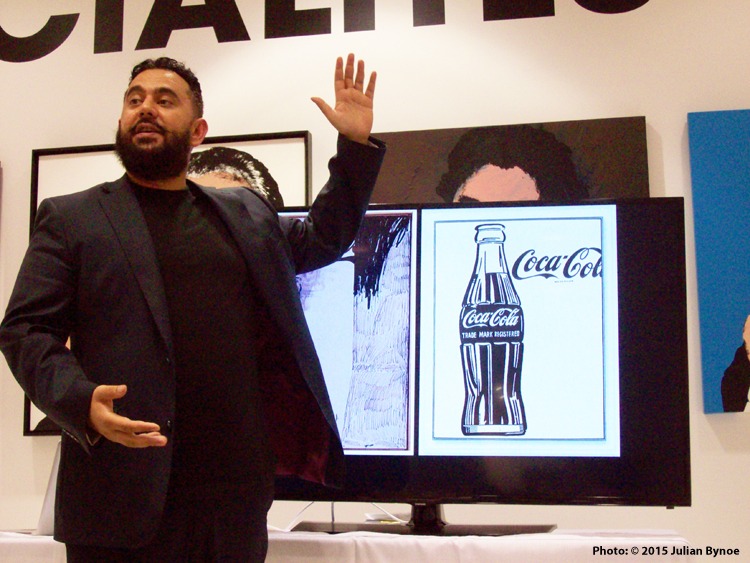Meraj Dhir: Pop Art in Context (Revolver Gallery)
Andy Warhol: Revisted Gallery, 77 Bloor Street West
Thursday, August 20; 8 p.m.
Trying to get into the headspace of Andy Warhol would take an excessive amount of time to consume on the man who redefined consumable art in the late-20th century for the masses. Crunching it to under a 90-minute timeframe within reason was Harvard-educated American art historian/critic Meraj Dhir who was in town on August 20 as part of the lecture series in the pop-up Andy Warhol: Revisited gallery to discuss the artist’s work in his forum, Pop Art in Context.
Quite animated in his persona and in the subject at hand, he went through the communicable experience of art and the public itself from medieval times up to Warhol’s own era with set examples surrounded by originals in the space, although Dhir spent the good first 60 minutes building a incredible backlog story on art history from that point of other pre-Pop Art artists from Da Vinci to Pollock and even his search for our own Pop artists drew a blank – and the funniest moment of the talk – where he jokingly said: “I wanted to add some Canadian content [to the slideshow], actually when I Googled ‘Canadian pop art,’ there was a picture of Justin Bieber that came up. So I figured there are no Canadian pop artists!”
In trying to justify all this prelude Dhir did put up a point that a work of art “exists within a kind of, you know, sort of a way that everyone could recognize it,” and Warhol did produce such art for most of his life which is much on display all around Revisted, from his repeated lithographs of Campbell Soup cans to Marilyn Monroe; copying from past artists from the kitsch era of the 1920s through to the post-World War II years in applying paint in various ways.
“What’s interesting in terms of the superimposition here, is the idea that art needs to open itself up to mass culture and what is mass culture in the (then-)age of television?” he explained. “And the televisual aspect in terms of almost of striving here in the visual field, which is very interesting among the elements.
“When Warhol painted all those Campbell Soup cans, for example, it was predetermined by the variety of soup cans, which was thirty-six; there were no more. So in a sense, it gave him the scheme he had to act and repeat (them), so he had this idea of repetition and variation becomes another one of his strategies within the neo-avant-garde. And what’s interesting is, that Warhol was a commercial illustrator for ten years before he entered the fine art world, but already here we see this impulsion toward ‘seriality’, his impulse toward repetition and variation, keeping the lids the same way [and he is thinking] ‘but how many times, how many different shapes can I organize them with?’ This was part of the significant breakthrough for Warhol and again, another way the neo-avant-garde was challenging the traditional notion of art…and this sort of idea that it’s unproblematically attained by the viewer.”
“Warhol wanted to become a fine artist and he realized that abstract expressionism was to become his own. So he took the kind of ready-made object, like commercial imagery, and introduced it here. But he also introduced various sort of sketchy elements that are likely abstract expressionist paintings, so he kind of conflated this commercial imagery with abstract expressionism.”
Continuing with the mechanization behind Warhol’s artistry Dhir also examined another side that’s present in his work. “There’s a dark undercurrent in Pop Art and here we see that where Warhol has repeated the image over and over again, but there are times when the image disappears,” which he presented a promotional photo of Monroe’s 1953 filmNiagara. “Warhol has taken that silkscreen and repeated it multiple times and this was created on the eve of her death (in 1962), so there’s a true ‘mourning’ of recognizing the disappearance of this star, this icon of female sexuality.
“But there’s something almost a bit aggressive here too, about the defacement; the kind of iconoclasm of the star image that occurs. So there’s no one right answers to all these ideas or all of these themes in such works that are fascinating.”
Dhir did a very good and smart presentation, but too much build-up on past artists before Warhol kind of hindered it despite the importance of it all and left out his cinematic work, perhaps of time limits, that was supposed to be discussed in the talk. Still, there were a lot of thoughtful and interesting stories involved concerning the power of image in art in all aspects and their usage found not just in Warhol’s work alone and the conceptual elements involved in its developmental process.
Andy Warhol: Revisted continues through December 31. For tickets/information, call 647-347-5355 or warholrevisted.com.


